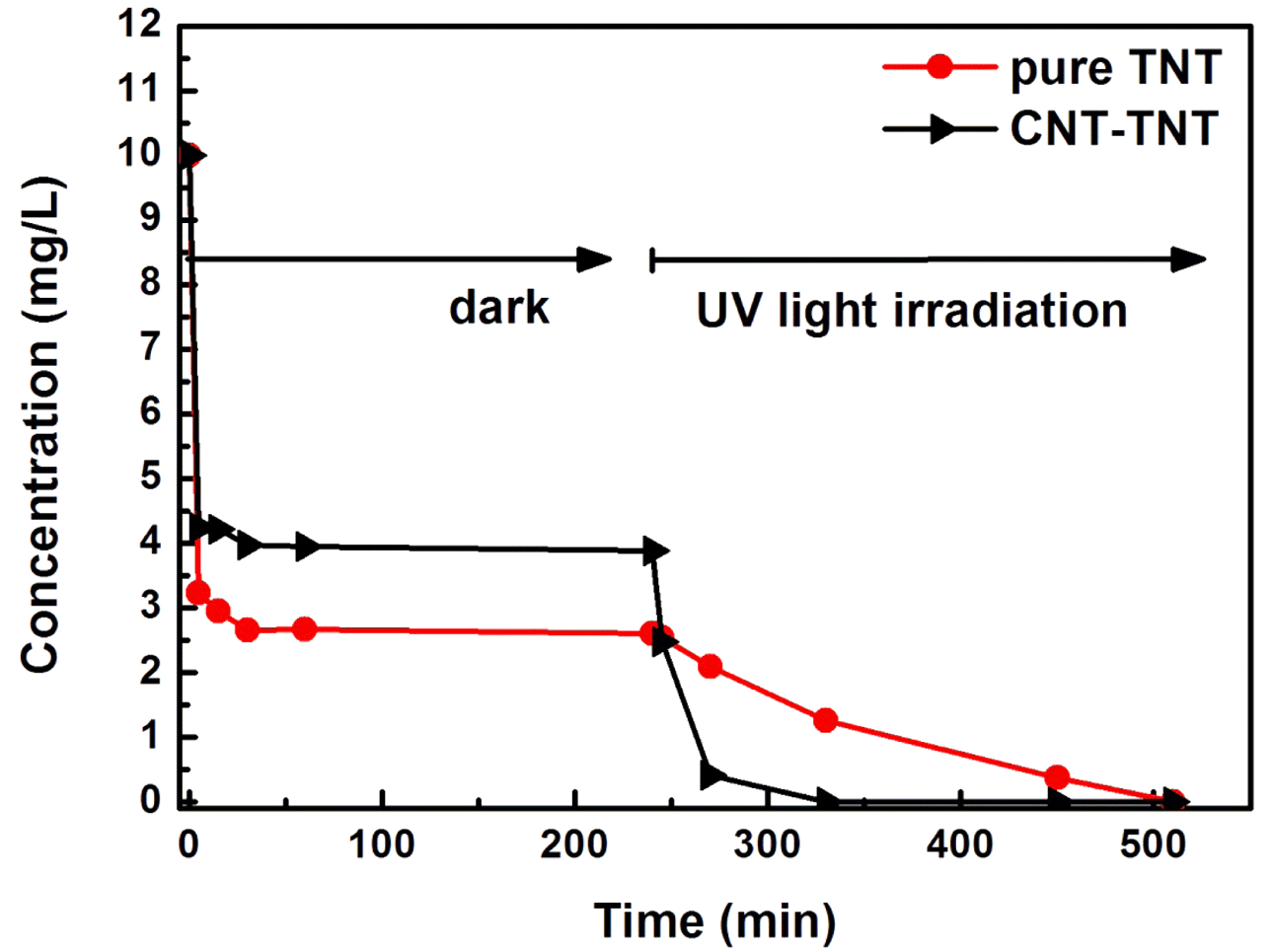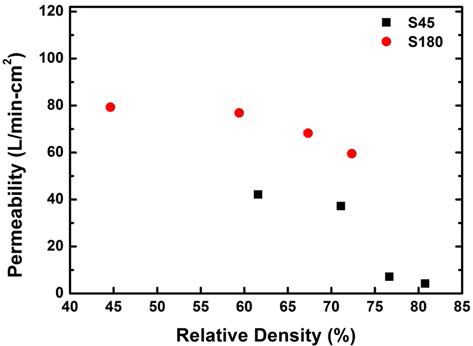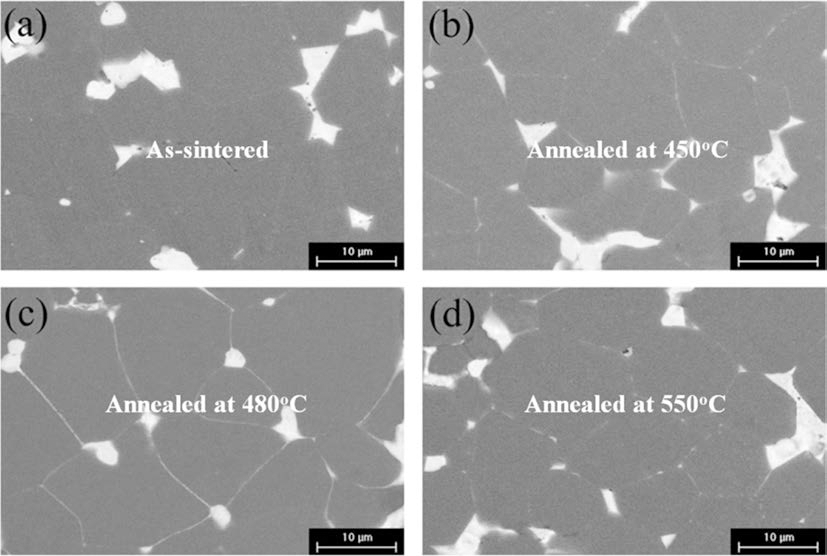Search
- Page Path
- HOME > Search
- [Korean]
- Interfacial Reaction between Spark Plasma Sintered High-entropy Alloys and Cast Aluminum
- Min-Sang Kim, Hansol Son, Cha Hee Jung, Juyeon Han, Jung Joon Kim, Young-Do Kim, Hyunjoo Choi, Se Hoon Kim
- J Powder Mater. 2022;29(3):213-218. Published online June 1, 2022
- DOI: https://doi.org/10.4150/KPMI.2022.29.3.213

- 711 View
- 4 Download
- 1 Citations
-
 Abstract
Abstract
 PDF
PDF This study investigates the interfacial reaction between powder-metallurgy high-entropy alloys (HEAs) and cast aluminum. HEA pellets are produced by the spark plasma sintering of Al0.5CoCrCu0.5FeNi HEA powder. These sintered pellets are then placed in molten Al, and the phases formed at the interface between the HEA pellets and cast Al are analyzed. First, Kirkendall voids are observed due to the difference in the diffusion rates between the liquid Al and solid HEA phases. In addition, although Co, Fe, and Ni atoms, which have low mixing enthalpies with Al, diffuse toward Al, Cu atoms, which have a high mixing enthalpy with Al, tend to form Al–Cu intermetallic compounds. These results provide guidelines for designing Al matrix composites containing high-entropy phases.
-
Citations
Citations to this article as recorded by- Simultaneous enhancement of strength and ductility of Al matrix composites enabled by submicron-sized high-entropy alloy phases
Chahee Jung, Seungin Nam, Hansol Son, Juyeon Han, Jaewon Jeong, Hyokyung Sung, Hyoung Seop Kim, Seok Su Sohn, Hyunjoo Choi
Journal of Materials Research and Technology.2024; 33: 1470. CrossRef
- Simultaneous enhancement of strength and ductility of Al matrix composites enabled by submicron-sized high-entropy alloy phases
- [English]
- The Synthesis and Photocatalytic activity of Carbon Nanotube-mixed TiO2 Nanotubes
- Chun Woong Park, Young Do Kim, Tohru Sekino, Se Hoon Kim
- J Korean Powder Metall Inst. 2017;24(4):279-284. Published online August 1, 2017
- DOI: https://doi.org/10.4150/KPMI.2017.24.4.279

- 1,228 View
- 11 Download
- 1 Citations
-
 Abstract
Abstract
 PDF
PDF The formation mechanism and photocatalytic properties of a multiwalled carbon nanotube (MWCNT)/TiO2- based nanotube (TNTs) composite are investigated. The CNT/TNT composite is synthesized via a solution chemical route. It is confirmed that this 1-D nanotube composite has a core-shell nanotubular structure, where the TNT surrounds the CNT core. The photocatalytic activity investigated based on the methylene blue degradation test is superior to that of with pure TNT. The CNTs play two important roles in enhancing the photocatalytic activity. One is to act as a template to form the core-shell structure while titanate nanosheets are converted into nanotubes. The other is to act as an electron reservoir that facilitates charge separation and electron transfer from the TNT, thus decreasing the electronhole recombination efficiency.
-
Citations
Citations to this article as recorded by- Low-Dimensional Carbon and Titania Nanotube Composites via a Solution Chemical Process and Their Nanostructural and Electrical Properties for Electrochemical Devices
Sunghun Eom, Sung Hun Cho, Tomoyo Goto, Myoung Pyo Chun, Tohru Sekino
ACS Applied Nano Materials.2019; 2(10): 6230. CrossRef
- Low-Dimensional Carbon and Titania Nanotube Composites via a Solution Chemical Process and Their Nanostructural and Electrical Properties for Electrochemical Devices
- [Korean]
- Fabrication and Mechanical Properties of STS316L Porous Metal for Vacuum Injection Mold
- Se Hoon Kim, Sang Min Kim, Sang Ho Noh, Jin Pyeong Kim, Jae Hyuck Shin, Si-Young Sung, Jin Kwang Jin, Taean Kim
- J Korean Powder Metall Inst. 2015;22(3):197-202. Published online June 1, 2015
- DOI: https://doi.org/10.4150/KPMI.2015.22.3.197

- 708 View
- 2 Download
- 2 Citations
-
 Abstract
Abstract
 PDF
PDF In this study, porous stainless steel (STS316L) sintered body was fabricated by powder metallurgy method and its properties such as porosity, compressive yield strength, hardness, and permeability were evaluated. 67.5Fe-17Cr- 13Ni-2.5Mo (wt%) powder was produced by a water atomization. The atomized powder was classified into size with under 45 μm and over 180 μm, and then they were compacted with various pressures and sintered at 1210°C for 1 h in a vacuum atmosphere. The porosities of sintered bodies could be obtained in range of 20~53% by controlling the compaction pressure. Compressive yield strength and hardness were achieved up to 268 MPa and 94 Shore D, respectively. Air permeability was obtained up to 79 l/min·cm2. As a result, mechanical properties and air permeability of the optimized porous body having a porosity of 25~40% were very superior to that of Al alloy.
-
Citations
Citations to this article as recorded by- Printability and physical properties of iron slag powder composites using material extrusion-based 3D printing
Hyungjin Kim, Sangkyu Lee
Journal of Iron and Steel Research International.2021; 28(1): 111. CrossRef - Study on Effects of Mold Temperature on the Injection Molded Article
J.-H. Han, Y.-C. Kim
Archives of Metallurgy and Materials.2017; 62(2): 1271. CrossRef
- Printability and physical properties of iron slag powder composites using material extrusion-based 3D printing
- [Korean]
- Enhancement of Coercivity for Nd-Fe-B Sintered Magnets
- Se Hoon Kim, Jin Woo Kim, Jong Min Byun, Young Do Kim
- J Korean Powder Metall Inst. 2015;22(1):60-67. Published online February 1, 2015
- DOI: https://doi.org/10.4150/KPMI.2015.22.1.60

- 1,330 View
- 11 Download
- 3 Citations
-
 PDF
PDF -
Citations
Citations to this article as recorded by- Study on the Demagnetization and Classification of NdFeB Magnets According to Different Heat Treatment Temperatures
Byeong Jun Kim, Ik Keun Park, Young Sung Kim
Journal of the Korean Society of Manufacturing Technology Engineers.2021; 30(2): 119. CrossRef - Study on Demagnetization and Magnetization to Reuse NdFeB-based Magnets
Byeong Jun Kim, Young Sung Kim, Gi Tae Joo, Joon Hyun Kim, Ik Geun Park, Jae Yong Lee, Su Won Yang
Journal of the Korean Society of Manufacturing Technology Engineers.2021; 30(4): 269. CrossRef - Study on the Optimization of Reduction Conditions for Samarium-Cobalt Nanofiber Preparation
Jimin Lee, Jongryoul Kim, Yong-Ho Choa
Journal of Korean Powder Metallurgy Institute.2019; 26(4): 334. CrossRef
- Study on the Demagnetization and Classification of NdFeB Magnets According to Different Heat Treatment Temperatures
- [Korean]
- A study on the Powder Injection Molding of Translucent Alumina via Flowability Simulation of Powder/Binder Mixture
- Hyung Soo Kim, Jong Min Byun, Se Hoon Kim, Young Do Kim
- J Korean Powder Metall Inst. 2014;21(3):215-221. Published online June 1, 2014
- DOI: https://doi.org/10.4150/KPMI.2014.21.3.215

- 507 View
- 0 Download
-
 Abstract
Abstract
 PDF
PDF Translucent alumina is a potential candidate for high temperature application as a replacement of the glass or polymer. Recently, due to the increasing demand of high power light emitting diode (LED), there is a growing interest in the translucent alumina. Since the translucent property is very sensitive to the internal defect, such as voids inside or abnormal grain growth of sintered alumina, it is important to fabricate the defect-free product through the fabrication process. Powder injection molding (PIM) has been commonly applied for the fabrication of complex shaped products. Among the many parameters of PIM, the flowability of powder/binder mixture becomes more significant especially for the shape of the cavity with thin thickness. Two different positions of the gate were applied during PIM using the disc type of die. The binder was removed by solvent extraction method and the brown compact was sintered at 1750°C for 3 hours in a vacuum. The flowability was also simulated using moldflow (MPI 6.0) with two different types of gate. The effect of the flowability of powder/binder mixture on the microstructure of the sintered specimen was studied with the analysis of the simulation result.
TOP
 KPMI
KPMI


 First
First Prev
Prev


